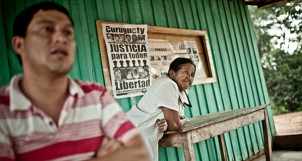It is commonly heard today that small farmers produce most of the world’s food. But how many of us realise that they are doing this with less than a quarter of the world’s farmland, and that even this meagre share is shrinking fast? If small farmers continue to lose the very basis of their existence, the world will lose its capacity to feed itself.

Alcides Raméon Ramírez, a member of one of 200 peasant families fighting to defend their land in Curuguaty, Paraguay. Eighty percent of the country’s land is in the hands of just two percent of landowners. (Photo: Pablo Tosco/Oxfam Intermon)
A new report by GRAIN takes an in depth look at the data to see what is going on — and the message is crystal clear. We need to urgently put land back in the hands of small farmers and make the struggle for agrarian reform central to the fight for better food systems.
They ask ‘if most of the world’s farmland is in small farmers’ hands, then why are so many of their organisations clamouring for land redistribution and agrarian reform?’ Because rural peoples’ access to land is under attack everywhere. From Honduras to Kenya and from Palestine to the Philippines, people are being dislodged from their farms and villages. Those who resist are being jailed or killed. Widespread agrarian strikes in Colombia, protests by community leaders in Madagascar, nationwide marches by landless folk in India, occupations in Andalusia – the list of actions and struggles goes on and on. The bottom line is that land is becoming more and more concentrated in the hands of the rich and powerful, not that small farmers are doing well.
Rural people don’t simply make a living off the land, after all. Their land and territories are the backbone of their identities, their cultural landscape and their source of well-being. Yet land is being taken away from them and concentrated in fewer and fewer hands at an alarming pace.
Then there is the other part of the picture: that concerning food. While it is now increasingly common to hear that small farmers produce the majority of the world’s food, even if that is outside of market systems, we are also constantly being fed the message that the “more efficient” industrial food system is needed to feed the world. At the same time, we are told that 80% of the world’s hungry people live in rural areas, many of them farmers or landless farmworkers.
How do we make sense of all this? What is true and what is not? What action do we take to deal with these imbalances? To help answer some of these questions, GRAIN decided to take a closer look at the facts, to find out how much land is really in the hands of small farmers, and how much food they produce on that land.
Read the full report here:
The report drew six major conclusions:
- The vast majority of farms in the world today are small and getting smaller
- Small farms are currently squeezed onto less than a quarter of the world’s farmland
- We are fast losing farms and farmers in many places, while big farms are getting bigger
- Small farms continue to be the major food producers in the world
- Small farms are overall more productive than big farms
- Most small farmers are women.

The project ENVJUSTICE has received funding from the European Research Council (ERC) under the European Union’s Horizon 2020 research and innovation programme (grant agreement No. 695446)